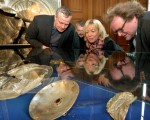 An unnamed and unauthorized metal detectorist found a late Roman gold and silver hoard in the forest near Ruelzheim in Germany’s southwestern Rhineland-Palatinate state and dug it up so he could sell it on the black market. The authorities are not releasing specifics on how this scofflaw was discovered hoarding an ancient hoard except to note that “the looter rendered up [the pieces] himself – but only under pressure from investigators.” That means they caught him first and persuaded him to surrender the loot. The police have reason to believe he may have already succeeded in selling some of the pieces overseas. They will continue to investigate the case, looking for missing artifacts. No announcement was made regarding whether the looter would be charged with any crimes.
An unnamed and unauthorized metal detectorist found a late Roman gold and silver hoard in the forest near Ruelzheim in Germany’s southwestern Rhineland-Palatinate state and dug it up so he could sell it on the black market. The authorities are not releasing specifics on how this scofflaw was discovered hoarding an ancient hoard except to note that “the looter rendered up [the pieces] himself – but only under pressure from investigators.” That means they caught him first and persuaded him to surrender the loot. The police have reason to believe he may have already succeeded in selling some of the pieces overseas. They will continue to investigate the case, looking for missing artifacts. No announcement was made regarding whether the looter would be charged with any crimes.
 By German law, all excavations for archaeological material must be authorized in advance by the government heritage authority. Different states have differing laws on the particulars. Some allow finders to keep half the value of a find, if not the find itself. The Rhineland-Palatinate is not one of them. Searching for ancient artifacts with a metal detector is a misdemeanor offence. Removing any artifacts discovered without reporting them rises to the level of fraud, and selling them can result in a charge of receiving stolen property.
By German law, all excavations for archaeological material must be authorized in advance by the government heritage authority. Different states have differing laws on the particulars. Some allow finders to keep half the value of a find, if not the find itself. The Rhineland-Palatinate is not one of them. Searching for ancient artifacts with a metal detector is a misdemeanor offence. Removing any artifacts discovered without reporting them rises to the level of fraud, and selling them can result in a charge of receiving stolen property.
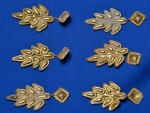 Certainly if monetary value plays a part in determining the severity of a property crime in Germany as it does in the US, this looter is going to be in big trouble. The hoard includes three dozen beautifully detailed solid gold brooches shaped like leaves, even more gold square pyramids that archaeologists believe all once ornamented a ceremonial tunic of an important Roman official. There’s also a silver dish with the remains of gilding still visible that was cut into pieces, possibly to be used as hacksilver, a solid silver bowl with gold accents inset with semi-precious stones, a crumpled and folded highly decorated silver plate that may have been a chest cover. A set of silver and gold statuettes and pieces of fittings are the remarkable survivors of what was once a curule seat, a commander’s portable folding chair.
Certainly if monetary value plays a part in determining the severity of a property crime in Germany as it does in the US, this looter is going to be in big trouble. The hoard includes three dozen beautifully detailed solid gold brooches shaped like leaves, even more gold square pyramids that archaeologists believe all once ornamented a ceremonial tunic of an important Roman official. There’s also a silver dish with the remains of gilding still visible that was cut into pieces, possibly to be used as hacksilver, a solid silver bowl with gold accents inset with semi-precious stones, a crumpled and folded highly decorated silver plate that may have been a chest cover. A set of silver and gold statuettes and pieces of fittings are the remarkable survivors of what was once a curule seat, a commander’s portable folding chair.
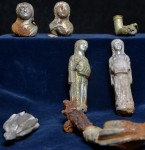 The hoard dates to the early part of the fifth century A.D., a time when Germanic tribes banged away at each other and at the weakening Roman Empire. The Battle of Mainz took place in 406 A.D. not far from where this treasure was buried and it was a watershed event in the collapse of Roman control of Europe. Pressured by Huns in the east, migrating allied tribes including Alans, Suevi and Vandals assembled on the east bank of the Rhine. The Franks sent a raiding party across the river and succeeded in killing the Vandal king Godigisel, but the Alans turned the tide and defeated the Franks. The tribes then crossed the Rhine into Gaul on December 31st,
The hoard dates to the early part of the fifth century A.D., a time when Germanic tribes banged away at each other and at the weakening Roman Empire. The Battle of Mainz took place in 406 A.D. not far from where this treasure was buried and it was a watershed event in the collapse of Roman control of Europe. Pressured by Huns in the east, migrating allied tribes including Alans, Suevi and Vandals assembled on the east bank of the Rhine. The Franks sent a raiding party across the river and succeeded in killing the Vandal king Godigisel, but the Alans turned the tide and defeated the Franks. The tribes then crossed the Rhine into Gaul on December 31st, 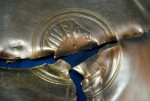 406, breaching what had been for centuries one of Rome’s strongest boundaries and pillaging Mainz, Rheims, Amiens and Strasbourg among many other Roman cities. It marked the end of Roman political and military control in northern Gaul and ushered in the Migration Period.
406, breaching what had been for centuries one of Rome’s strongest boundaries and pillaging Mainz, Rheims, Amiens and Strasbourg among many other Roman cities. It marked the end of Roman political and military control in northern Gaul and ushered in the Migration Period.
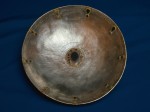 It’s no wonder why someone might have sought to bury his most precious treasures under these circumstances. The jewels from ceremonial clothing, the elaborate silver and gold folding chair and the exquisite silver tableware all point to them having been the belongings of an important magistrate or even royalty. These were the highly recognizable attributes of Roman political authority. They were buried near a former Roman road, whether by its original owner of by marauders who wanted to keep it safe from competing marauders, in a relatively shallow hole. It’s a testament to how dangerous the roads were that nobody made it back to reclaim so vast a treasure.
It’s no wonder why someone might have sought to bury his most precious treasures under these circumstances. The jewels from ceremonial clothing, the elaborate silver and gold folding chair and the exquisite silver tableware all point to them having been the belongings of an important magistrate or even royalty. These were the highly recognizable attributes of Roman political authority. They were buried near a former Roman road, whether by its original owner of by marauders who wanted to keep it safe from competing marauders, in a relatively shallow hole. It’s a testament to how dangerous the roads were that nobody made it back to reclaim so vast a treasure.
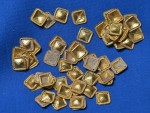 The age and nature of this hoard makes it a unique find in Germany, worth at least a million euro on the market and worth far more than that in historical value. It would be worth inestimably more if it had been excavated with respect for its context. Instead, the looter pulled whatever he could out of the ground, having no care whatsoever for archaeological integrity. According to state archaeologist Axel von Berg, the curule chair, for example, was “brutally torn out of the earth and destroyed.” The site itself was deliberately damaged. Boy would I love to see this thief prosecuted just for doing that.
The age and nature of this hoard makes it a unique find in Germany, worth at least a million euro on the market and worth far more than that in historical value. It would be worth inestimably more if it had been excavated with respect for its context. Instead, the looter pulled whatever he could out of the ground, having no care whatsoever for archaeological integrity. According to state archaeologist Axel von Berg, the curule chair, for example, was “brutally torn out of the earth and destroyed.” The site itself was deliberately damaged. Boy would I love to see this thief prosecuted just for doing that.
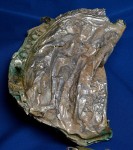 Meanwhile, some people are getting excited over the prospect that this could be part of the legendary Nibelung hoard, the Rhine gold that features in Norse and German sagas and Richard Wagner’s opera cycle based upon them. The evidence for this is nonexistent, of course. The fifth century dating and the location somewhere in the vague area where the Rhine may have once flowed but doesn’t any longer is all it took for the legend buzz to start.
Meanwhile, some people are getting excited over the prospect that this could be part of the legendary Nibelung hoard, the Rhine gold that features in Norse and German sagas and Richard Wagner’s opera cycle based upon them. The evidence for this is nonexistent, of course. The fifth century dating and the location somewhere in the vague area where the Rhine may have once flowed but doesn’t any longer is all it took for the legend buzz to start.
The treasure will soon go on display in Mainz and Speyer.